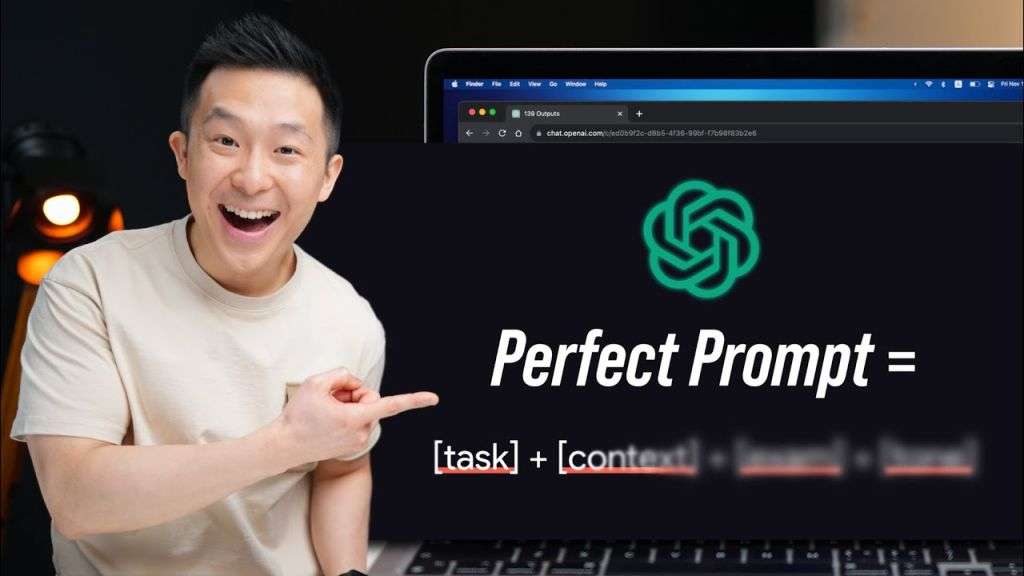Imagine unlocking the secrets to flawless conversations with AI in a mere eight minutes. Your guide, Jeff Su, expertly navigates through the art of crafting the perfect prompt, ensuring you’re equipped to elicit the best possible responses from ChatGPT and Google Bard. As you embark on this insightful journey, you’ll discover the six essential components that form the backbone of any successful interaction: Task, Context, Exemplars, Persona, Format, and Tone. This potent blend of elements, when applied with skill, transforms your prompts into clear, targeted requests that invite highly accurate and relevant responses from the AI, elevating your chat experience to new heights.
With your attention captivated, Jeff doesn’t just offer theories but illuminates the path with practical, real-world examples, providing a hands-on approach to mastering prompts. Whether you’re seeking to fine-tune the AI’s persona to match your scenario or aiming for the precision of Tone to reflect your intended voice, this video serves as an indispensable blueprint. By integrating these components, you’ll witness the transformation of ordinary prompts into powerful tools that bend AI capabilities to your will, saving you time and enhancing productivity. Just sit back, spare eight minutes of your day, and prepare to command the digital conversation like never before.

Understanding the Components of a ChatGPT Prompt
Crafting the perfect ChatGPT prompt is an essential skill that can lead to impressively tailored results. Get comfortable: let’s break it down!
Explaining the 6 key components
You’re dealing with a ChatGPT or Google Bard prompt, and you’ve got six elements to juggle – Task, Context, Exemplars, Persona, Format, and Tone. Each one is a piece of the puzzle that creates a comprehensive request for the AI.
How each component influences the output
Your Task dictates what you want done; it’s the AI’s directive. The Context grounds your request in specific details, providing relevant background. Exemplars are like templates, showing the AI what you’re aiming for. Persona gives the AI a role to play; it’s the “who” that the AI embodies. Format is about the structure of the output, the visual layout, or the type of content you expect. Tone sets the mood for the response, adding flavor to the way information is delivered.
Prioritizing the components for effectiveness
Prioritize based on what’s most important for your request. Usually, an understandable Task and adequate Context are crucial. Exemplars, Persona, and Tone add nuance and specificity, while Format ensures the response is in a usable state. Remember, sometimes less is more if each element is well structured.
Crafting the Task Sentence
Make your task the spearhead of your prompt.
Starting with a clear action verb
Kick off with an action verb – “Create,” “Analyze,” “Summarize”. That’s your prompt’s engine!
Articulating the end goal
What’s the bullseye? Be explicit about the result you want – “Outline a 3-month workout plan for a 70-kg male.”
Differences between simple and complex tasks
Tasks can be a simple one-liner or a multi-layered request. A simple task might be a direct “List the top 5 productivity hacks.” A complex task could involve several steps like analysis, insight, and categorization.
Defining Context
The context is like giving the AI a lens through which to view the task.
The balance of information in a prompt
Provide enough background to guide but not so much that the AI gets bogged down.
Three guiding questions for context
Ask yourself: what’s the user’s background, what does success look like, and what’s the environment? These aim your prompt true.
What to include and what to omit
Include essential details that influence the task, like “I can only go to the gym twice a week,” but omit unnecessary fluff.
Incorporating Exemplars
Exemplars refine your prompt into a well-oiled machine.
Improving output quality with examples
Providing a concrete example for the AI to mimic can vastly improve quality – like showing a resume structure for the AI to follow.
Real-world applications for exemplar usage
Use cases abound in demonstrations, storytelling, or content matching a specific format – real gems for specificity!
How exemplars guide the AI’s response
They’re signposts that point the AI in the direction you want it to go – “Write an email in the tone of this example.”

Choosing the Right Persona
The persona is the mask you ask the AI to wear; it’s a role assignment.
Determining the ideal AI personality
Imagine the expert or the personality that best suits your task – a marketing guru for a promotional copy perhaps.
How persona shapes the response
Choosing the persona steers the dialogue tone, level of formality, and depth of knowledge in the response – a physical therapist persona will talk differently than a financial advisor.
Examples of effective persona prompts
Asking the AI to respond as a specific individual can yield colorful responses – like asking the AI to draft an email as Batman would.
Selecting the Appropriate Format
The format is your blueprint for the response’s structure – an essential for clarity.
Visualizing the desired output
Close your eyes. Imagine the result. Do you see a bullet-point list? A detailed report? Structure your prompt to manifest this vision.
Different formats and when to use them
Different situations call for different formats. Summaries for briefings, tables for data-heavy texts. Choose wisely.
Format tips for professional productivity
Strategies like asking the AI to highlight changes in bold can immediately signal revisions, saving time and enhancing workflow.

Adjusting Tone
The tone adds color to the conversation, a sprinkle of mood to the content.
The impact of tone on delivery
Tone can mean the difference between a response that’s warm and approachable and one that’s cold and alienating.
Finding the right tone keywords
Think about the emotion you want to evoke – use words like “friendly,” “enthusiastic,” or “professional” to guide the AI.
Tone adjustments for specific situations
Different scenarios call for different vibes. Pitching to a client? Stay professional. Storytelling? Perhaps a dash of whimsy.
Real Example Analysis
Dissecting examples teaches you the nuances of good prompting.
Breaking down a perfect prompt step-by-step
Analyzing a well-crafted prompt reveals how every part works together, harmoniously driving toward the desired outcome.
Understanding good vs. bad prompt outputs
Why did one prompt succeed and another fizzle? Dissecting outputs hones your prompt-smithing skills.
Learning from real prompt examples
Real-world prompts provide edible lessons in what to do – and just as importantly – what not to do.
Prompt Efficiency Techniques
It’s all about trimming the fat while keeping the meat.
Efficient information provisioning
Provide just enough context to inform but not overwhelm – like giving the AI just the right amount of backstory.
Streamlining prompts without losing quality
A well-oiled prompt is concise but powerful – it uses the fewest words to achieve the maximum effect.
When to simplify and when to elaborate
Simplicity is best for straightforward tasks. When nuance is key, more detail may be necessary. Know when to switch gears.
Conclusion
You now have the blueprint to the perfect ChatGPT prompt.
Recap of the perfect ChatGPT prompt formula
Remember the critical components: Task, Context, Exemplars, Persona, Format, and Tone. Each plays their part in crafting a precise and effective prompt.
Encouragement to practice and experiment
Use the tips you’ve learned as a starting point. Experiment, practice, refine – and watch your AI interactions improve!
Final thoughts on mastering prompts quickly
Like any skill, prompt crafting gets better with practice. Keep at it, and you’ll no doubt become adept at eliciting the best from ChatGPT in no time.
There you have it, a pathway to prompt prowess! Keep crafting those prompts, and your digital assistant will be churning out gold before you know it. Happy prompting!


